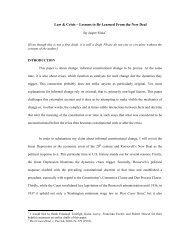Guide to Foreign and International Legal Citations - New York ...
Guide to Foreign and International Legal Citations - New York ...
Guide to Foreign and International Legal Citations - New York ...
You also want an ePaper? Increase the reach of your titles
YUMPU automatically turns print PDFs into web optimized ePapers that Google loves.
I. COUNTRY PROFILE (Civil Law)<br />
54<br />
FINLAND<br />
Suomen Tasavalta (Republic of Finl<strong>and</strong>)<br />
The Republic of Finl<strong>and</strong>, established December 6, 1917, is a sovereign republic. Finl<strong>and</strong><br />
(Suomi) is subdivided in<strong>to</strong> six provinces <strong>and</strong> operates under a civil legal system. The two<br />
official languages are Finnish <strong>and</strong> Swedish. All laws are published in both official languages. In<br />
addition, the Sámi people of Lapl<strong>and</strong>, the northern region of Finl<strong>and</strong>, hold the constitutionally<br />
protected right <strong>to</strong> publish laws in the Sámi language. Finl<strong>and</strong> entered in<strong>to</strong> membership of the<br />
European Union on January 1, 1995.<br />
Finl<strong>and</strong>’s Constitution was adopted March 1, 2000. Prior <strong>to</strong> that date, the country was<br />
governed by four Constitutional Acts: The Constitution Act of Finl<strong>and</strong> (1919), the Parliament<br />
Act, <strong>and</strong> two ministerial liability acts. The Constitution is the supreme law of the l<strong>and</strong> <strong>and</strong> is the<br />
source of all public power. It enshrines the fundamental principle that sovereign power lies with<br />
the Finnish people represented by the Parliament.<br />
The state is organized on the basis of a separation of powers between the Government,<br />
Parliament, the President, <strong>and</strong> the courts. Executive power lies with the Government<br />
(valtioneuvos<strong>to</strong>) with certain duties carried out by the President (tasavallan presidentti). The<br />
President is elected directly by majority vote, with a second run-off election held if necessary,<br />
for a term of six years. The President must be a native Finnish citizen <strong>and</strong> is limited <strong>to</strong> two terms<br />
in office. The Prime Minister is elected by Parliament <strong>and</strong> appointed by the President. Other<br />
ministers are appointed by the President based upon nominations by the Prime Minister. The<br />
Government or Council of Ministers is made up of the Prime Minister (Pääministeri) <strong>and</strong> a<br />
maximum of seventeen Ministers (Ministeri). The Government is the decision-making body for<br />
governmental <strong>and</strong> administrative matters consisting of the Government plenary session <strong>and</strong> the<br />
ministries. <strong>Foreign</strong> policy is directed by the President in conjunction with the Government. The<br />
Government has the authority <strong>to</strong> forward proposals for legislation <strong>to</strong> the Parliament for<br />
enactment.<br />
The legislative power lies with the Parliament (eduskunta). Finl<strong>and</strong> has a unicameral<br />
Parliament consisting of 200 seats. Chapter Six of the Constitution provides that the principal<br />
duty of Parliament is <strong>to</strong> enact legislation. Members of Parliament are elected directly by popular<br />
vote <strong>to</strong> four-year terms, although the President, after consulting with Parliament, may order a<br />
new election prior <strong>to</strong> the end of that term if the Prime Minister so advises. Parliament may adopt<br />
Acts, which must be submitted <strong>to</strong> the President for ratification. Following signature by the<br />
President, the Act is published in the official statute book. Acts which are not ratified within<br />
three months, or which are ve<strong>to</strong>ed by the President, are returned <strong>to</strong> the Parliament, <strong>and</strong> they may<br />
still enter in<strong>to</strong> force if there is sufficient support in Parliament, provided that no further<br />
amendments are made.<br />
Judicial power lies with the Courts (tuomioistuimet). Finl<strong>and</strong> has a three-tiered<br />
hierarchical system of courts. Sixty-six first instance District Courts (käräjäoikeus) have<br />
jurisdiction <strong>to</strong> hear both civil <strong>and</strong> criminal matters in terri<strong>to</strong>rially limited districts. Their<br />
decisions may be appealed <strong>to</strong> one of six regionally organized Courts of Appeal (hovioikeus),<br />
which also have first instance jurisdiction over certain governmental <strong>and</strong> treason matters. The<br />
highest court is the Supreme Court of Finl<strong>and</strong> (korkein oikeus). Appeals from decisions of the<br />
Court of Appeal are heard only with leave of the Supreme Court, usually by a panel of five
















